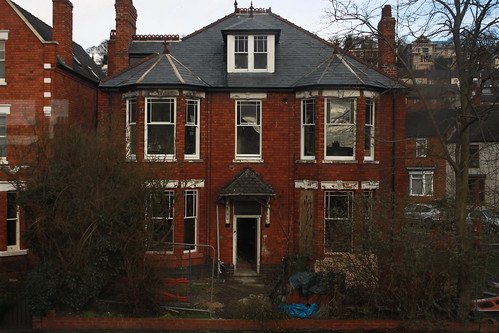In getting a ticket for our performance our audience members fall subject to a false sense of security- they are welcome in the house because we have allowed them to be there but we do not actually live there. Is it really our home to invite them into? Are they really welcome? And are they really safe?
When I think of a ‘safe house’ I think of a discreet property that houses an occupant who needs to be kept safe from something or one. It is a temporary base for a hidden person. It is structurally a house, but very rarely a home, just as our property is, blending in nicely with the surrounding area.
Image by Jozey Wade 2013
In my experience of fictional ‘safe houses’ on television or in film the houses are very rarely safe and are often infiltrated by the enemy. While this is obviously for entertainment purposes the characters responsible for the victim are left shocked and confused as to how anyone could have seen past their high security system. But the answer is clear to me: a safe house is only as safe as or maybe even less safe than any other house on the street: it is just as easy to break into, just as likely to be burgled and because of its ‘secret’ resident, a much higher target of crime.
It is also easy to assume that those kept in safe houses are there under the protection of the law: someone in danger, someone on parole, someone whose identity is too precious to be introducing themselves to their neighbours without an alias. However, research has shown that ‘safe houses’ are often used against the legal system for other purposes. Human smuggling and trafficking for example require safe houses in which illegal migrants can be housed without being discovered. Leman and Jansses state that in some countries “large smuggling networks in which the victims have a long way to travel need safe houses to conduct their business.” (( Leman, J, & Jansses, S “The Various ‘Safe’-House Profiles in East-European Human Smuggling and Trafficking.” Journal of Ethnic and Migration Studies Vol. 33, No. 8, November 2007, pp. 1380 )). It has been found that in these situations the safe houses may not only be used for temporary accommodation, but as a prison in which the migrants are held as hostage while their families are forced to pay more money for their safety or a brothel like establishment. Statistics suggest “that a minimum of 50 percent and upward of 80 percent of human trafficking victims worldwide are women (U.S. Department of State 2005; U.S. Department of State 2010). Seventy percent of female victims are trafficked into the sex trade…” (( Perdue, T, Williamson, C, Billings, M, Schart, J, & Boston-Gromer, R 2011, ‘In the Matter of Human Trafficking in Ohio: The Pursuit for Justice Continues’, Women’s Policy Journal Of Harvard, 8, pp. 4, viewed 17 April 2013. )).
While this statistic is disturbing, it appears that one room in our house has accidentally created a performance that could, when paired with the title of our piece, have a deeper meaning than was previously intended. The set up of the sexual element of the bedroom piece could easily represent not only a sex slave in terms of a BDSM arrangement but also a hostage situation in which a woman kept as a sex slave in a ‘safe house’.
While the bedroom is perhaps the most controversial room in our house, I’m not sure our audience will feel safe in the hostile living room environment or the peculiar child’s room environment either, especially considering that the technology normally used for a persons security is being used to scrutinise their every move.
